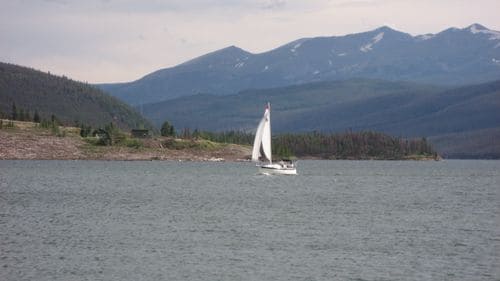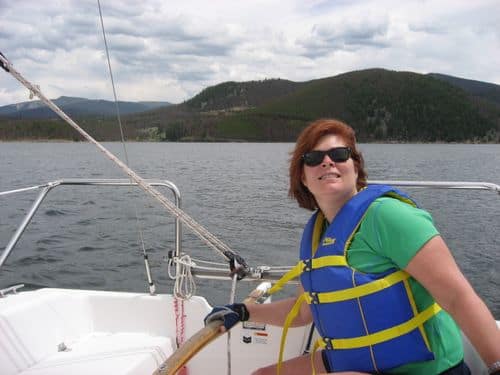Despite the fact that we are having a vacation at 9,000 feet above sea level in landlocked Colorado, it would not be a good vacation without some kind of sailing. Fortunately we have Lake Dillon on hand. In the coffee table book, Fifty Places to Sail Before You Die, Lake Dillon is listed as one of the best places to sail in the US. It is certainly unique. Pat of a Desert Sea, also lists it in the top 12 places to sail in the Desert and Mountain Southwest. 
I can see why it gets the accolades. It’s actually a reservoir created by a dam. While it’s a fairly restricted waterway, about 10 windey miles long but only a couple of miles wide at its fattest, the scenery is second to none. I have been lucky enough to sail in the Caribbean, the Solent, up and down the Eastern Seaboard and the Med but the views from Lake Dillon take the prize. You are surrounded by the Rockies. This of course also creates some interesting conditions.
Alice and I rented a Catalina 22 from Lake Dillon Marina. As neither of us had any sailing documentation with us, they put us through a quick sailing quiz. Most of the questions were about how you would deal with adverse conditions. This was our first clue to what sailing on Lake Dillon could be like.
Next we went down to the dock to be greeted by two friendly dock hands, Donny a pony-tailed guy from PR with a Quebecois accent (don’t ask me why) and Stevo, a boat restorer who had worked on the restoration of some magnificent yachts.
In my experience, dock-hands come in two flavors: Competent guys and gals who know their stuff and give you good advice or sullen teenagers who are just doing this as a summer job. The boats usually reflect the dock hand. Fortunately, Lake Dillon is the former. The boats and the assistance were excellent.
The Catalina 22 was clean, well-equipped, well-maintained, i.e. nothing was broken and everything was in good repair. Next was the briefing by Donny. Normally, when I get these kind of briefings, my eyes glaze over. The typical safety briefing for anything you rent on a vacation from bicycle to ATV seems to be designed for …well, you know, morons: “Don’t drive off a cliff as that will hurt” kinda thing. This briefing was a serious.The gist of it was like this:
- There is no such thing as a prevailing wind on Lake Dillon, as the wind comes off the mountains and can come from any direction (That said, for us, it mostly came out of the North-east from across the dam).
- Winds can vary from zero to 70 kts (yes that was 70) at any moment. Most of the time the heavy winds are short gusts but 40 to 70 kts winds for an hour were possible. In fact that morning, they had had 40 kts for 45 minutes. In the last week they had 70 kts for an even longer period with boats pinned to one side of the lake for 2 hours. Fun, fun, fun.
- Keep looking around you for wind. It can come from any direction. As it’s a lake you can easily see it coming. Whitecaps mean a 40 kt gust was heading your way; waves mean 70 kts were coming. By the sounds of it, this lake could go from mill-pond to Fastnet Force 10 in picoseconds.
- The small boat had a brand-spanking new 9.9 HP 4-stroke outboard so that if things got too hairy you could motor-back in any condition. It was a perfect little outboard and given the issues I have with my own, I had unnatural thoughts about this beauty.
- It was advisable to wear a life-jacket as capsizes happen with greater frequency than most other places you have sailed (See 2). Donny had barely got halfway through the briefing and Alice was tripping over me and anything in the way to grab a life-vest. I followed her example.
- If the conditions got tough, shut the cabin up tight to prevent the boat from filling on a knock-down. I laughed nervously at this but Donny assured me that one of their boats had sunk because the cabin was open when a big gust knocked the boat over. Gulp!
- “No swimming” was not some liability BS but a very serious warning. At the surface the water was cool but pleasant. Below a few feet the temp was in the 30s. If you sank below the surface, odds were good that you would keep going 300 feet to the bottom. If you capsize and cannot get back in the boat you might not last two minutes. Double gulp!
We got under way, Alice at the helm, me on the sheets. We usually sail like this as Alice is as good if not better on the helm and I want to be able to power the boat down quickly. Frankly we were nervous. As advertised, the wind went up and down. Mostly it was about 15 kts but it could die to nothing or burst up in 30+ puffs. We weren’t getting knocked down but we were getting pushed over past comfort in the big puffs. 
To make matters more exciting and as advertised, the winds shifted like nothing I have experienced. The steady winds veered and backed by 30-45 degrees. In the narrower inlets, the wind died and would swing 180 degrees.
After about 30 minutes we got the hang of it. Alice feathered the boat in gusts, heading up quickly. If things got too harsh, I eased sheets. The more confident we got the less I had to do this. Anxiety turned to fun. We stayed in the fat of the lake and had a lot of fun sailing the course laid out for regattas. Heading to the windward mark was challenging but we started to figure out how to read the puffs and ride the lifts. On the reach and downwind legs, the boat really shifted. For a rental, the Catalina 22 sailed beautifully.
And as you can see from the photos the surrounding scenery was amazing. We started the sail thinking we were heading for certain death but by paying attention to local knowledge and trusting our skills we had a wonderful sail.
We started the sail thinking we were heading for certain death but by paying attention to local knowledge and trusting our skills we had a wonderful sail.

Sadly, a few (usually novice) sailors are lost at Lake Tahoe every year in just the conditions you describe.
I remember floating off a beach there one day in a rubber raft when the wind was mostly about five knots. But every 15 minutes, almost like clockwork, a single 25-knot gust would come through, scattering hats and beach umbrellas.
In the middle of the lake, the gusts are stronger.
The science dudes who study lakes (limnologists) have a name for the sharp drop in temperature below a certain depth. They call it a ‘thermocline’. I think it’s common to all deep lakes at high altitudes that are fed by snowmelt.
Actually, besides the icy temperatures below the thermocline, there’s another reason that swimming is not permitted: The lake provides drinking water for the city of Denver, and the Denver Water Authority doesn’t want it getting dirty.
Of course, sometimes people end up swimming in the lake but not on purpose.
Sounds like a great day out. Thanks!
It’s not always so dramatic, but mountain lake weather is certainly changeable.
Also, at Dillon you’ll notice fewer powerboats than usual for most places; that’s because powerboats lose a lot of power at the lake’s 9017-foot surface elevation.
The lake’s longest dimension is only about 4.3 miles but it feels bigger because of the rugged terrain, clear cool air, numerous coves, islands, and arms of the lake.
The surface area is five square miles (3200 acres) with the deepest spot about 210-220 feet deep just southwest of Dillon Dam. The main area south of the dam measures about 1 mile (statute/land) north-south from the dam to near Windy Point and 2 miles WSW-ENE from Crown Point to Dillon.
During the summer, there’s a sailboat shop in Dillon. (In winter it’s a ski shop, or at least was as of the last time I was around town.) Frisco has a Wal-Mart and various auto parts and other shops are in the immediate area. Aurora (Denver suburb) has a West Marine.
We never had a huge amount of trouble with gusts when we sailed Dillon, but we may have been lucky, plus we have a very well ballasted boat and are pretty much accustomed to mountain lake wind trickery.
Some coves, particularly in the NW part of the lake, such as adjacent to Giberson or Heaton bays, provide some protection for smaller craft.
One concern for visitors bringing boats to Dillon is that incoming boats must be inspected (business hours) to ensure that they don’t contaminate the lake with alien quagga or zebra mussels (drysenids).
Water from the lake goes east in a tunnel under the Continental Divide to reach Denver.
This year’s Dillon Open had about 70 keelboats and 15 centerboarders (separate course) racing. Tillerman would have found eleven other Lasers with whom to compete had he been there. There were also fleets for J/24s, J/22s, J/80s, Ultimate 20s, Start, Pearson Ensigns, as well as PHRF A (racers) and PHRF B (mostly cruisers).
Fishermen are said to be able to catch rainbow and brown trout, arctic char, and kokanee salmon.
A little correction–according to the map, the long axis of the lake from Dillon – Sentinel Island – Frisco is more or less north – south or at least NNE – SSW. I think the mountain air had me turned around.
Your blog has an I liked the faith! You defend your interests, I get my light, nothing more.
Oh this is exciting to sail on Catalina yacht in a lake. It is the best highest quality yachts in the sailing industry. But make sure to have a proper guidance from an experienced sailor prior to your sailing to avoid any dangers.
I really enjoyed to read your post, looks like you gays had terrific time. I also a love to sail in beautiful places, this summer we took a vacation to Alaska and sailed there in Icy waters, that was wonderful experience.
I had been browsing on google for blogs about Hiking and cycling when this post showed up in the results. Although not actually what I was looking for it was actually worth the read and for that I would give it four stars.
The boats are often a reflection of the main dock. Fortunately, Lake Dillon is the first. The boats and the attendance was excellent.